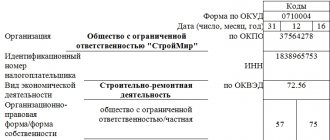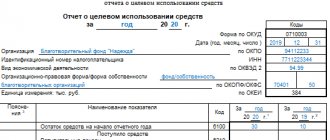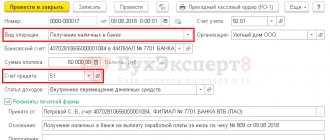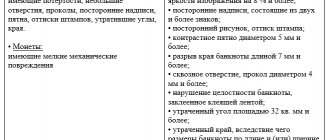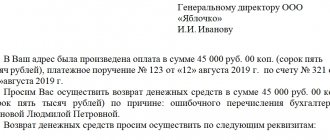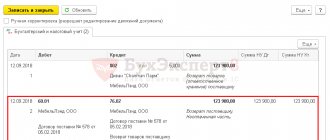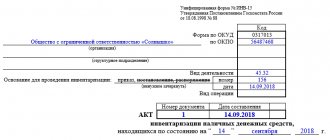The cash flow statement reflects the organization's cash flows - the company's payments and the receipt of cash and cash equivalents into the company and their balances at the beginning and end of the reporting year. When drawing up a report, follow PBU 23/2011.
Cash equivalents are, for example, demand deposits opened in banks.
Bargain transactions and mutual offsets do not generate cash flows.
Cash flows are not:
- investing money in cash equivalents and repaying them (excluding interest);
- foreign exchange transactions (except for losses or gains received);
- exchange of one monetary equivalent for another (except for losses or benefits received);
- receiving cash from a bank, transferring money from one account to another and other transactions that do not change the amount of funds.
General requirements
When filling out the report, distribute the cash flows among the three types of activities of the company:
- current;
- investment;
- financial.
Cash flows from current operations are associated with the normal operations of the firm.
These are, in particular:
- receipts from buyers for goods (work, services);
- rent, commissions;
- payments to suppliers for goods, materials (work, services);
- payments in favor of employees;
- payments of income tax from ordinary activities;
- payment of interest on debt obligations, except for interest included in the cost of investment assets;
- cash flows on short-term (no more than three months) financial investments purchased for resale.
Cash flows from investing activities are associated with the acquisition, creation or disposal of a firm's non-current assets. This is, for example:
- related payments to the firm's suppliers, contractors and employees, including R&D costs;
- interest included in the cost of investment assets;
- proceeds from the sale of non-current assets;
- proceeds from the sale of shares and interests in other organizations (except for short-term ones acquired for resale);
- provision of loans to other persons and their repayment;
- payments and receipts for settlements for debt securities;
- dividends from participation in other organizations, etc.
Cash flows in the form of receipts from buyers and customers, payments to suppliers and contractors should be shown in the report without indirect taxes (VAT and excise taxes). The cash flow related to each of these taxes is shown in collapsed form - the total amount for the year (paragraph “b”, paragraph 16 of PBU 23/2011). This rule has been in effect since 2011. VAT and excise taxes must be separated from cash equivalents received or used as a means of payment.
Important
The procedure for filling out a cash flow statement is discussed in detail in the book “Annual Report 2012″, edited by Vladimir Meshcheryakov.”
Along with the useful book, you will receive a free access code to the Internet portal in support of submitting the annual report www.buhgod.ru and will be able to use the book in electronic format.
Cash flows from financing activities are payments that result in changes in the size and structure of a firm's capital and leverage.
For example:
- cash contributions from owners (contributions to property), proceeds from the issue of shares, increases in shares;
- payments to owners for shares purchased from them or in connection with their withdrawal from the company;
- dividends to owners;
- receipts and payments from the issue of debt securities;
- loans and borrowings from other persons (receipt and repayment).
Fill out the header part of the report in the same way as the corresponding part of the balance sheet and other forms:
Structure of the DDS report
The report is divided into three main parts:
- section I – Cash flows from current operations;
- section II – Cash flows from investment operations;
- section III – Cash flows from financial transactions.
In this case, cash flows mean payments that the company makes in favor of other organizations, as well as cash receipts (both in cash and non-cash form).
The procedure for entering information into the report is as follows:
- divide all payments and receipts into categories according to the sections of the report. If it is impossible to unambiguously classify the flow, assign the amount to section I;
- for each category, determine the amount of expenses, receipts and balance for the reporting period;
- compare the reporting indicators (balances) at the end of the year with similar ones at the beginning of the current year, and then reflect the information in the report.
It should be noted that the DDS report does not include information on flows associated with:
- investing in cash equivalents;
- foreign exchange transactions;
- exchange of cash equivalents.
Also, when reflecting information in the report, the amount of transactions for the internal movement of non-cash funds in the organization’s accounts, cash withdrawal from a bank account, cash delivery to the bank’s cash desk, etc. is not taken into account.
Cash flows from current operations
The main source of income is money received from buyers and customers. Therefore, in line 4111 of the report, reflect the revenue received from the sale of products (goods, works, services) and the amount of advances from buyers minus indirect taxes - VAT and excise taxes. To fill it out, summarize the debit turnover of the cash and cash equivalents accounts (50, 51, 52, 55, 58) in correspondence with account 62 “Settlements with buyers and customers” or 76 “Settlements with various debtors and creditors” (for a loan) . From these turnovers it is necessary to exclude the amounts of VAT and excise taxes received from buyers.
In line 4112, enter the amounts of royalties, rent, licenses, commissions and other similar payments excluding VAT.
Show other income on line 4113 “Other income”. It can be:
- amounts returned to the cash desk by accountable persons;
- amounts received in compensation for damage from the perpetrators or the insurer;
- received fines, penalties, penalties for violations of contract terms, etc. (minus received VAT).
Payments received from tenants for the use of your property can be reflected in the report in different ways. This depends on whether the rental of property is a normal activity of the company. If yes, then enter the rent received in the line “from the sale of products, goods, works and services.” If not, then include it in other income.
In lines 4121-4129 of the report, disclose the main areas of spending funds.
Please note: the expense of cash and cash equivalents is indicated in the report in parentheses. VAT and excise taxes paid to suppliers and contractors are not included in the cash flow.
On line 4121 “suppliers (contractors) for raw materials, materials, works, services” show the company’s paid expenses for current activities. Enter here the amounts of payments made to your suppliers (contractors). Take the necessary data from the credit turnover of cash accounting accounts (50, 51, 52) in correspondence with account 60 “Settlements with suppliers and contractors” or 76 “Settlements with various debtors and creditors” (by debit). From them you need to subtract the VAT paid to contractors. But the transfer of cash equivalents to counterparties (their disposal) is reflected through subaccount 91-2 “Other expenses”. In addition, cash can be spent through accountable persons.
On line 4122 of the cash flow statement, include the amounts of wages paid to the company's employees. In this case, use the data on the debit of account 70 “Settlements with personnel for wages” in correspondence with the credit of account 50 (if salaries are issued from the cash register) or 51 (if salaries are transferred to employees’ plastic cards).
If in the reporting (last) year the company paid interest on debt obligations, then show their amount in line 4123 of the report.
Show the payment of income tax on line 4124. Show the payment of all other taxes, except indirect ones, as well as mandatory social insurance contributions on line 4129.
If the company received a refund of overpaid taxes from the budget, with the exception of VAT and excise taxes, or contributions from state extra-budgetary funds, then reflect these receipts on line 4119.
These amounts are identified in accounting through the correspondence of account 51 with accounts 68 “Calculations for taxes and fees” and 69 “Calculations for compulsory social insurance”.
Show other paid expenses for current activities in the line “other payments”.
Summarize the total cash flow associated with current activities in line 4100 “Balance of cash flows from current operations.” Reflect in it the difference between the amounts of money received and spent and cash equivalents for the current activities of the company.
Show the amount of VAT, as well as excise taxes related to current activities, in a collapsed form.
An example explains how to do this. Example
In the reporting year, JSC Aktiv, while carrying out its current activities, received from buyers and customers VAT in the amount of 500,000 rubles as part of cash and cash equivalents, paid suppliers and contractors a total of VAT in the amount of 400,000 rubles, and transferred it to the budget 150,000 rubles, and received compensation in the amount of 350,000 rubles from the budget. The cash flow for VAT amounted to RUB 300,000. (500,000 - 400,000 - 150,000 + 350,000). The Aktiva accountant will show this amount (300 thousand rubles) on line 4119 of the profit and loss report for the reporting year.
Meanwhile, separate accounting of VAT cash flows for current, investment and financial activities is usually not carried out (letter of the Ministry of Finance of Russia dated January 27, 2012 No. 07-02-18/01). With a collapsed VAT reflection, the total total of tax receipts and payments is displayed, including all receipts from buyers and customers, all payments to suppliers and contractors, as well as payments to the budget and refunds from it. The total amount is reflected as part of cash flows from current operations - on the line “Other payments” (code 4119) or “Other receipts” (code 4129). The same applies to excise taxes.
Cash flows from investment operations
First, analyze your receipts.
On line 4211 “from the sale of non-current assets” of the report, indicate the amounts that the company received from the sale of fixed assets, intangible assets, capital construction in progress and equipment for installation (excluding VAT).
This data is taken from debit turnover on accounts 50, 51, 52, 58, subaccount “Cash equivalents” (minus received VAT), in correspondence with account 62 “Settlements with buyers and customers” or 76 “Settlements with various debtors and creditors” .
In line 4212 of the report, indicate the company’s income from the sale of shares (participatory interests) in other organizations, and on line 4214 - income in the form of dividends and interest on debt financial investments. Take data on dividends from debit turnover on accounts 50, 51, 52, 58, sub-account “Cash equivalents”, in correspondence with account 76 “Settlements with various debtors and creditors”, sub-account “Settlements for dividends”.
To identify the amount of interest that your company actually received in the reporting year from financial investments (for example, bonds, bills, loans issued, etc.), you need to take the debit turnover on accounts 50, 51, 52 in correspondence with account 76 “Calculations with different debtors and creditors”, subaccounts “Interest on bills”, “Interest on bonds”, etc.
Show repayment of interest-bearing loans issued in line 4213.
Let us remind you that in accounting these transactions are reflected in the debit of account 50 or 51 in correspondence with account 58 “Financial investments”.
Receipts from investment activities not listed in lines 4211-4214 of the report are reflected in line 4219 “other receipts”.
Next, reveal your payment structure.
In line 4221 “in connection with the acquisition, creation, modernization, reconstruction and preparation for use of non-current assets” of the report, reflect the payment in the reporting year of fixed assets (real estate, production equipment, etc.), intangible assets (rights to patents, inventions and etc.), exploration assets (in connection with the development of natural resources), as well as objects of unfinished capital investments - excluding VAT. Take the data for this line from credit turnover on accounts 50, 51, 52, 55, 58, sub-account “Cash equivalents” (minus VAT), in correspondence with accounts 60 and 76 regarding purchases of fixed assets, intangible assets, etc. In addition, cash for these purposes can be spent through accountable persons.
Record the amount of funds allocated for long-term financial investments in lines 4222 “in connection with the acquisition of shares (participation interests) in other organizations” and 4223 “in connection with the acquisition of debt securities (rights to claim funds against other persons), provision of loans to other persons." To fill out these lines, take the necessary data from the turnover in the debit of account 58. Although cash equivalents are reflected in account 58, they are not long-term assets.
Show the result of cash flows from investment activities in line 4200 “Balance of cash flows from investment operations.” That is, enter here the difference between the amounts of money and cash equivalents received and spent as part of investment activities.
Interest payments are shown as part of current transactions (line 4123), unless you include them in the cost of investment assets. In the latter case, show interest as part of investment transactions (line 4224).
It is difficult to overestimate the importance, and therefore the accuracy, of drawing up a cash flow statement. We present to your attention an excerpt from the book “Annual Report 2012, edited by Vladimir Meshcheryakov,” which describes in some detail the process of compiling this part of the final documents. You can view and purchase the book here
Cash flows from financial transactions
Here, disclose information about money received and spent within the financial activities of the company.
Indicate the amounts received by the company in debt in the line “receipt of loans and borrowings.” To fill out this line, use the credit turnover of accounts 66 “Calculations for short-term loans and borrowings” and 67 “Calculations for long-term loans and borrowings” in correspondence with the cash accounts (50, 51, 52, 55) and cash equivalents (58) .
Let us remind you that sometimes loans are formalized not by an agreement, but by issuing your own bill. A bill of exchange loan, just like regular loans, is reflected in account 66 or 67, depending on the repayment period. However, to reflect such borrowings, the report provides a separate line - 4314 “from the issue of bonds, bills and other debt securities, etc.”
In lines 4312 and 4313, reflect the contributions of the company's owners made in the reporting year. For example, if participants made contributions to property in accordance with Article 27 of Law No. 14-FZ of February 8, 1996, show their amounts on line 4312. Other income should be indicated on line 4314. In particular, this includes state assistance (PBU 13/2000 ).
In the line “in connection with the repayment (redemption) of bills and other debt securities, repayment of loans and borrowings,” write down the amounts of loans and borrowings you repaid. Use the data on the debit of accounts 66 “Calculations for short-term loans and borrowings” and 67 “Calculations for long-term loans and borrowings” in correspondence with accounts for accounting for cash and cash equivalents.
If your company paid dividends, you need to fill out the line “for the payment of dividends and other payments for the distribution of profits in favor of the owners (participants).” Here indicate the amounts of all dividends paid in the reporting year.
In the line “Balance of cash flows from financial transactions,” reflect the difference between money received and spent and cash equivalents from the company’s financial operations.
Form No. 4 “Cash Flow Statement”
Accounting statements for the year using the fourth form can be generated in the section “Manager/Monitor of taxes and reporting/Accounting statements”.
Fig.6 ODDS form
When creating a report form, the monetary amounts registered by item will be attributed to one or another type of movement of assets, depending on the items specified when posting the relevant documents.
Let's demonstrate the above with an example. Let’s assume that through “Receipts to account” under the movement item “Receipts from the sale of products and goods, performance of work, provision of services” a payment from the buyer was recorded in the amount of 102,135.00 rubles, including VAT of 15,579.92 rubles.
Fig.7 Details “DDS Article” of the document “Receipt on account”
In the setting of the article we are considering, the type of movement of the same name is indicated.
Fig.8 Setting up the item sales receipts
Thus, the registered payment from the buyer under the DDS article with the type of movement “Receipts from the sale of products and goods, performance of work, provision of services” on form No. 4 of the report will be included in the total amount on line 4111 “Receipts from the sale...”.
Fig.9 Payment from the buyer in ODDS
Decoding line 4111 allows you to see the components of the total amount for this line. In our example, the final amount of 87 thousand rubles was obtained as the difference between the amount of payment from the buyer of 102,135.00 rubles and VAT of 15,579.92 rubles (86,555.08 ~ 87 thousand rubles).
Fig. 10 Explanation for line 4111 “Proceeds from the sale...”


